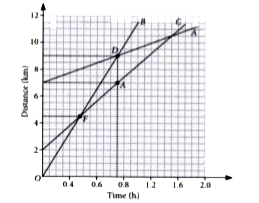Which of the following is true for displacement ?
(a) It cannot be zero.
(b) Its magnitude is greater than the distance travelled by the object.
The correct Answer is:(a) False (b) False
To determine which of the statements regarding displacement is true, we will analyze each statement one by one.
Step 1: Analyze Statement (a)
- Statement (a): "It cannot be zero."
- Displacement is defined as the shortest distance from the initial position to the final position of an object, along with the direction. If an object returns to its starting point, the initial and final positions are the same, resulting in a displacement of zero.
- Conclusion: This statement is false because displacement can indeed be zero.
Step 2: Analyze Statement (b)
- Statement (b): "Its magnitude is greater than the distance travelled by the object."
- The distance travelled by an object is the total path length covered, while displacement is the straight-line distance between the initial and final positions. In general, the magnitude of displacement can be less than or equal to the distance travelled, but it cannot be greater.
- For example, if an object moves in a circular path and returns to the starting point, the distance travelled is greater than zero, but the displacement is zero.
- Conclusion: This statement is also false because the magnitude of displacement is always less than or equal to the distance travelled.
Final Conclusion:
Both statements (a) and (b) are false regarding displacement.
---
- Statement (a): "It cannot be zero."
- Displacement is defined as the shortest distance from the initial position to the final position of an object, along with the direction. If an object returns to its starting point, the initial and final positions are the same, resulting in a displacement of zero.
- Conclusion: This statement is false because displacement can indeed be zero.
- Statement (b): "Its magnitude is greater than the distance travelled by the object."
- The distance travelled by an object is the total path length covered, while displacement is the straight-line distance between the initial and final positions. In general, the magnitude of displacement can be less than or equal to the distance travelled, but it cannot be greater.
- For example, if an object moves in a circular path and returns to the starting point, the distance travelled is greater than zero, but the displacement is zero.
- Conclusion: This statement is also false because the magnitude of displacement is always less than or equal to the distance travelled.
Both statements (a) and (b) are false regarding displacement.
Topper's Solved these Questions
- BOOK - PRADEEPCHAPTER - MOTIONEXERCISE - NCERT Exercises10videos
MOTION
- BOOK - PRADEEPCHAPTER - MOTIONEXERCISE - NCERT short answer question7videos
MOTION
- BOOK - PRADEEPCHAPTER - MOTIONEXERCISE - Mock test24videos
MOTION
- BOOK - PRADEEPCHAPTER - GRAVITATIONEXERCISE - Model Test paper (1)36videos
GRAVITATION
- BOOK - PRADEEPCHAPTER - SOUNDEXERCISE - Model Test (sec - B)12videos
SOUND
Similar Questions
Knowledge Check
- Question 1 - Select One
Which of the following cannot displace hydrogen from steam ?
ACdBFeCCrDZn - Question 2 - Select One
Which of the following cannot travel through Vacuum?
ALight wavesBHeat wavesCX - raysDSound waves - Question 3 - Select One
Which of the following cannot travel through Vacuum?
ALight wavesBHeat wavesCX-raysDSound waves
Can displacement be greater than distance?
View SolutionWhen a particle is undergoing motion, the diplacement of the particle has a magnitude that is equal to or smaller than the total distance travelled by the particle. In many cases the displacement of the particle may actually be zero, while the distance travelled by it is non-zero. Both these quantities, however depend on the frame of reference in which motion of the particle is being observed. Consider a particle which is projected in the earth's gravitational field, close to its surface, with a speed of 100√2m/s, at an angle of 45∘ with the horizontal in the eastward direction. Ignore air resistance and assume that the acceleration due to gravity is 10m/s2.
There exists a frame (D) in which the distance travelled by the particle is minimum. This minimum distance is equal to :-View SolutionGiven figure shows the distance - time graph of three object A, B and C as time is taken on x- axis and distance is taken on y - axis . The slope of the distance - time graph of an object represents its speed .
The magnitude of displacement equal to the distance travelled by the object , then we can use the term uniform velocity in place of uniform speed

Which pair out of the three objects A, B and C travelled equal distance at any point ?View SolutionWhich of the following has ΔS∘ greater than zero
View SolutionGiven figure shows the distance - time graph of three object A, B and C as time is taken on x- axis and distance is taken on y - axis . The slope of the distance - time graph of an object represents its speed .
The magnitude of displacement equal to the distance travelled by the object , then we can use the term uniform velocity in place of uniform speed

When B passes a distnace travelled by C isView Solution
